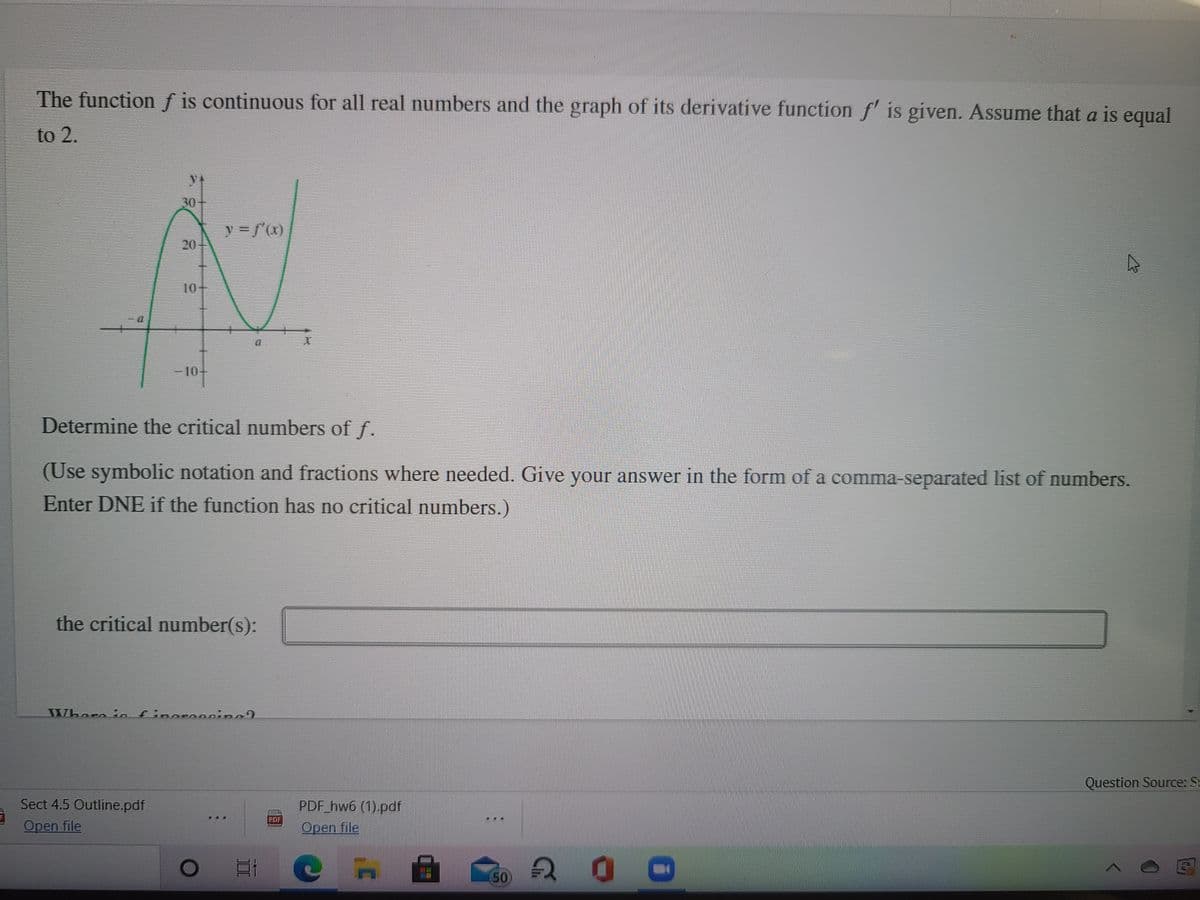The function f is continuous for all real numbers and the graph of its derivative function f' is given. Assume that a is equal to 2. y = f(x) 20- 10+ -10- Determine the critical numbers of f.
The function f is continuous for all real numbers and the graph of its derivative function f' is given. Assume that a is equal to 2. y = f(x) 20- 10+ -10- Determine the critical numbers of f.
College Algebra (MindTap Course List)
12th Edition
ISBN:9781305652231
Author:R. David Gustafson, Jeff Hughes
Publisher:R. David Gustafson, Jeff Hughes
Chapter3: Functions
Section3.3: More On Functions; Piecewise-defined Functions
Problem 99E: Determine if the statemment is true or false. If the statement is false, then correct it and make it...
Related questions
Question
Please also help me find the local max and min, if any.

Transcribed Image Text:The function f is continuous for all real numbers and the graph of its derivative function f' is given. Assume that a is equal
to 2.
30
10-
-10-
Determine the critical numbers of f.
(Use symbolic notation and fractions where needed. Give your answer in the form of a comma-separated list of numbers.
Enter DNE if the function has no critical numbers.)
the critical number(s):
Where io finoro0ning9
Question Source: St
Sect 4.5 Outline.pdf
PDF hw6 (1).pdf
Open file
POF
...
Open file
20
50
20
![Where is f increasing?
(Use symbolic notation and fractions where needed. Give your answers as intervals in the form (*, *). Use the symbol co for
infinity, U for combining intervals, and an appropriate type of parenthesis "(", ")", "[" or "]" depending on whether the
interval is open or closed. Enter Ø if the interval is empty.)
f is increasing on
Where is f decreasing?
(Use symbolic notation and fractions where needed. Give your answers as intervals in the form (*, *). Use the symbol co for
infinity, U for combining intervals, and an appropriate type of parenthesis "(". ")", "[" or "I" depending on whether the
interval is open or closed. Enter Ø if the interval is empty.)
f is decreasing on
Question Source: Sulliva
PDF hw6 (1).pdf
Open file
Sect 4.5 Outline.pdf
TDF
Open file
a 自
50](/v2/_next/image?url=https%3A%2F%2Fcontent.bartleby.com%2Fqna-images%2Fquestion%2F08156d39-b854-45f2-9d90-7fd147414e14%2Fddb98d77-4e3b-4134-90b5-3763757b7062%2F3limvsb_processed.jpeg&w=3840&q=75)
Transcribed Image Text:Where is f increasing?
(Use symbolic notation and fractions where needed. Give your answers as intervals in the form (*, *). Use the symbol co for
infinity, U for combining intervals, and an appropriate type of parenthesis "(", ")", "[" or "]" depending on whether the
interval is open or closed. Enter Ø if the interval is empty.)
f is increasing on
Where is f decreasing?
(Use symbolic notation and fractions where needed. Give your answers as intervals in the form (*, *). Use the symbol co for
infinity, U for combining intervals, and an appropriate type of parenthesis "(". ")", "[" or "I" depending on whether the
interval is open or closed. Enter Ø if the interval is empty.)
f is decreasing on
Question Source: Sulliva
PDF hw6 (1).pdf
Open file
Sect 4.5 Outline.pdf
TDF
Open file
a 自
50
Expert Solution
This question has been solved!
Explore an expertly crafted, step-by-step solution for a thorough understanding of key concepts.
This is a popular solution!
Trending now
This is a popular solution!
Step by step
Solved in 3 steps with 1 images

Knowledge Booster
Learn more about
Need a deep-dive on the concept behind this application? Look no further. Learn more about this topic, calculus and related others by exploring similar questions and additional content below.Recommended textbooks for you

College Algebra (MindTap Course List)
Algebra
ISBN:
9781305652231
Author:
R. David Gustafson, Jeff Hughes
Publisher:
Cengage Learning


College Algebra (MindTap Course List)
Algebra
ISBN:
9781305652231
Author:
R. David Gustafson, Jeff Hughes
Publisher:
Cengage Learning
